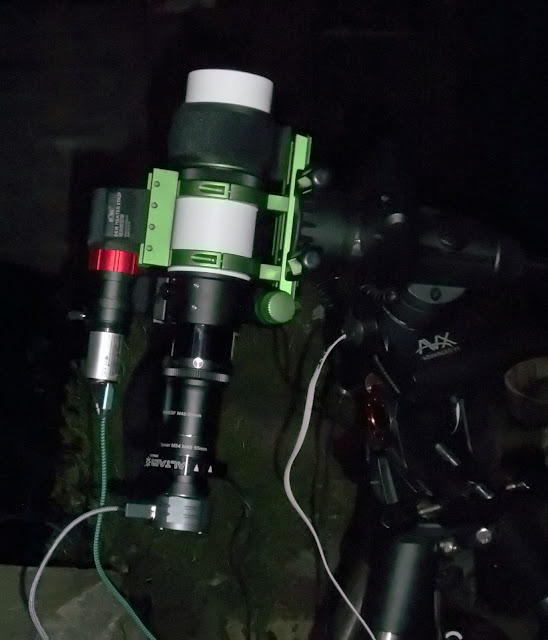Deep Sky with the SVBONY SV705C uncooled, 12 bit CMOS camera and AstroDMx Capture for Windows.
The SV705C is marketed as a Planetary camera suitable for EAA (Electronically Assisted Astronomy)
It has the SONY IMX585 zero amp glow sensor with 3856 x 2180 maximum resolution.
The sensor is 11.2mm x 6.3mm with 2.9µm x 2.9µm pixels.
The SV705C was placed at the focus of an Altair Starwave 60 ED Imaging refractor fitted with a 0.8 flattener reducer and an Altair magnetic filter holder.
The scope was mounted on a Celestron AVX mount and the mount was connected to an INDI server.
Auto-guiding was done by PHD2 running on a separate computer using an SVBONY SV165 guide-scope fitted with a QHY-5II-M guide camera.
The INDI server was running in an Oracle VirtualBox Linux virtual machine as described in a previous article.
The equipment used
The stacked flats image shows the necessity of capturing flat fields.
A UV/IR cut filter was placed in the filter holder for the first imaging session.
AstroDMx Capture sent the mount/scope to the bright star Rigel, plate solved using the offline ASTAP solver and centred the star for focusing with a Bahtinov mask.
AstroDMx Capture for Windows then sent the mount/scope to the Hokeystick galaxy NGC4656. Once plate solved and centred, the Whale galaxy NGS4631 was in the same field of view.
AstroDMx Capture was used to capture 1h 16m worth of 2 minute exposures and matching dark frames.
The Whale and Hokeystick galaxies
The filter was then changed to an Altair Quadband filter that passes the light from H-beta, OIII, H-alpha and SII. AstroDMx Capture was used to send the mount/scope to M16, the open cluster and the Eagle Nebula.
AstroDMx Capture was used to capture 1h 12m worth of 3 minute exposures and matching dark frames.
The data were stacked and partly processed in Siril and post-processed in the Gimp 2.10, Fitswork 4 and Neat Image.
The Eagle nebula
The SV705C proved to be a capable deep sky imager and the zero amp glow facilitated a pleasant imaging experience.
It is important to realise that although the sensor produces zero amp glow it is important to capture dark frames because hot pixels and fixed thermal noise would spoil the final image if they were not removed.



.png)
.png)

.png)
.png)
